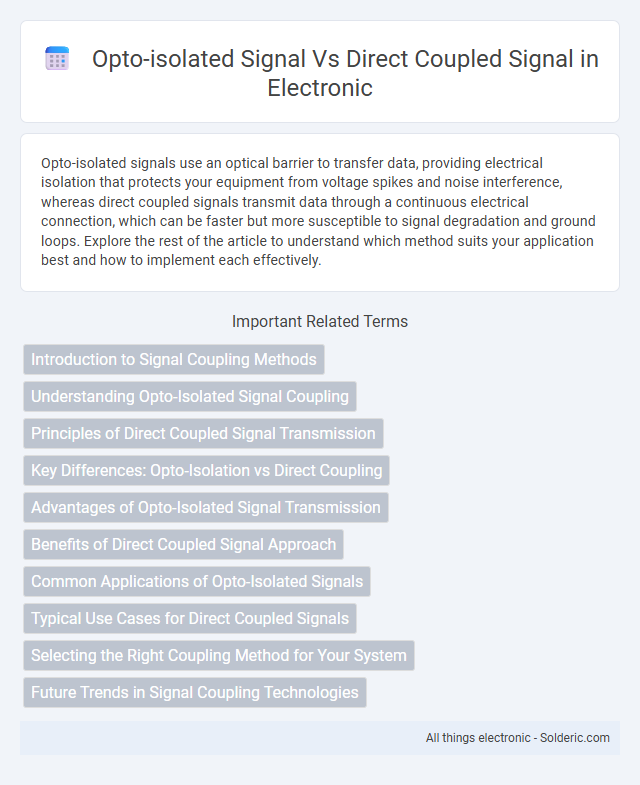Opto-isolated signals use an optical barrier to transfer data, providing electrical isolation that protects your equipment from voltage spikes and noise interference, whereas direct coupled signals transmit data through a continuous electrical connection, which can be faster but more susceptible to signal degradation and ground loops. Explore the rest of the article to understand which method suits your application best and how to implement each effectively.
Comparison Table
| Feature | Opto-Isolated Signal | Direct Coupled Signal |
|---|---|---|
| Isolation | Galvanic isolation via LED and phototransistor | No galvanic isolation |
| Noise Immunity | High noise immunity, reduces ground loops | Lower noise immunity, susceptible to interference |
| Signal Integrity | Maintains signal integrity over long distances | Signal degradation possible over long cables |
| Voltage Level Compatibility | Allows interface between different voltage domains | Requires matched voltage levels |
| Speed | Typically slower due to LED response time | Faster signal transmission |
| Cost | Higher cost due to extra components | Lower cost, simpler design |
| Application | Used in noisy environments, safety-critical circuits | Used in low noise, simple coupling systems |
Introduction to Signal Coupling Methods
Opto-isolated signals use optical components like LEDs and phototransistors to transfer electrical signals while providing electrical isolation between circuits, reducing noise and protecting sensitive equipment. Direct coupled signals transmit electrical signals without isolation, allowing faster response times but increasing the risk of ground loops and interference. Choosing between opto-isolated and direct coupled methods depends on application requirements for noise immunity, signal integrity, and safety.
Understanding Opto-Isolated Signal Coupling
Opto-isolated signal coupling uses an LED and photodetector to transfer electrical signals, providing galvanic isolation and preventing ground loops and electrical noise interference. Direct coupled signals transmit electrical signals through a direct conductor connection, which can introduce noise and pose risks of ground potential differences. Opto-isolation enhances signal integrity and protects sensitive electronics in industrial automation and communication systems.
Principles of Direct Coupled Signal Transmission
Direct coupled signal transmission relies on a continuous electrical connection between circuits, allowing the direct flow of current and voltage signals without intermediary components. This method ensures fast, accurate signal transfer with minimal latency but lacks inherent isolation, which can expose your system to noise, ground loops, and potential damage from voltage spikes. Understanding the principles of direct coupling helps optimize signal integrity in environments where electrical isolation is not critical.
Key Differences: Opto-Isolation vs Direct Coupling
Opto-isolated signals use an LED and photodetector to transfer data electrically isolated, preventing ground loops and reducing noise interference, while direct coupled signals connect circuits electrically without isolation. Opto-isolation provides enhanced safety and signal integrity in high-voltage or noisy environments, whereas direct coupling offers faster response times and simpler circuit design. Understanding these key differences helps optimize your system's performance and reliability based on isolation needs and signal speed requirements.
Advantages of Opto-Isolated Signal Transmission
Opto-isolated signal transmission provides superior electrical isolation, protecting your sensitive equipment from voltage spikes and ground loops that can damage circuits or cause measurement errors. This method improves noise immunity by preventing unwanted interference from external electromagnetic sources, ensuring cleaner and more reliable signal integrity. Opto-isolators also enable safe interfacing between different voltage levels and ground potentials, enhancing overall system safety and longevity.
Benefits of Direct Coupled Signal Approach
Direct coupled signals offer faster response times and improved signal integrity by eliminating the delay and distortion introduced by opto-isolators. Your design benefits from lower component count and reduced power consumption, simplifying circuitry and enhancing reliability in high-speed or precision applications. This approach ensures seamless signal transfer, especially in environments where isolation is not critical but signal fidelity is paramount.
Common Applications of Opto-Isolated Signals
Opto-isolated signals are commonly used in industrial automation, medical equipment, and communication systems to ensure electrical isolation and protect sensitive components from voltage spikes and noise. These signals enhance safety and reliability by preventing ground loops and minimizing interference in environments with high electromagnetic disturbance. Your systems benefit from improved signal integrity and reduced risk of damage when employing opto-isolation in critical data transmission and control applications.
Typical Use Cases for Direct Coupled Signals
Direct coupled signals are commonly used in applications requiring real-time, low-latency communication between circuits, such as sensor data acquisition and analog signal processing. They are ideal for environments where signal integrity is maintained without the need for electrical isolation, like within a single PCB or system module. Typical use cases include temperature sensor outputs, motor control feedback loops, and direct interfacing between microcontrollers and analog devices.
Selecting the Right Coupling Method for Your System
Choosing between opto-isolated signal and direct coupled signal depends on system requirements for noise immunity and signal integrity. Opto-isolated coupling provides galvanic isolation, minimizing ground loop interference and protecting sensitive components in industrial or high-voltage environments. Direct coupled signals offer faster response times and simpler implementation, ideal for low-noise, short-distance applications where isolation is less critical.
Future Trends in Signal Coupling Technologies
Future trends in signal coupling technologies emphasize the increasing adoption of opto-isolated signals due to their superior noise immunity and safety in high-voltage environments compared to direct coupled signals. Advances in semiconductor materials and LED efficiency are driving more compact, faster optocouplers with enhanced bandwidth and lower power consumption, enabling their use in high-speed industrial and automotive applications. Integration with smart sensors and IoT devices further accelerates the shift from direct coupling methods, offering improved signal integrity and electrical isolation in complex, interconnected systems.
opto-isolated signal vs direct coupled signal Infographic

 solderic.com
solderic.com